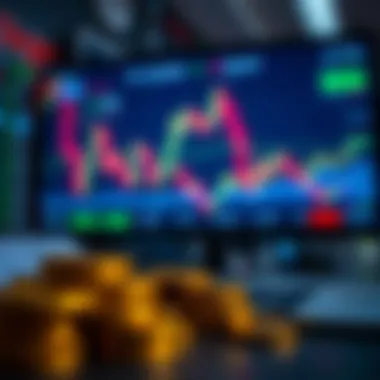Maximize Your Trading Potential on TradingView


Intro
In the ever-evolving realm of cryptocurrency, keeping a finger on the pulse of market dynamics is paramount. With volatilities reminiscent of a rollercoaster ride, both novice and seasoned traders are constantly seeking fresh insights and strategies. This is where TradingView steps in—as a powerful tool that not only allows users to analyze data but also empowers them to curate and develop trading ideas based on real-time information.
Understanding how to navigate TradingView can make a difference between profit and loss. In this article, we’ll break down the essentials, from fundamental aspects of cryptocurrency to how you can leverage TradingView’s features for informed trading decisions. Let’s start with the basics to create a solid foundation.
Prelude to TradingView
In the rapidly evolving world of cryptocurrency trading, having access to the right tools can make all the difference. This is where TradingView comes into play. It serves not just as a charting tool, but as a comprehensive platform catering to traders looking to analyze, strategize, and execute their trades effectively. Understanding TradingView is crucial for anyone involved in the cryptocurrency market, whether you're a seasoned trader or just dipping your toes in the water.
What makes this platform stand out is its robust community features combined with powerful technical analysis tools. As traders flock to this platform to share their ideas, gain insights, and enhance their trading decisions, grasping how to navigate and utilize these resources becomes invaluable.
The benefits of using TradingView are numerous. It allows users to access an array of charts and indicators, customize their layouts, and even automate trading strategies. The social element of the platform means traders can learn from one another, exchanging knowledge and strategies that can help refine their approaches.
So, what exactly is TradingView involved with? This guide takes a deep dive into the platform, peeling back the layers to uncover its potential benefits. From setting up your account to harnessing the power of charts and market analysis, this guide aims to equip you with a thorough understanding of how to navigate TradingView effectively and maximize your trading outcomes. Let's explore the fundamentals.
Setting Up Your TradingView Account
Setting up your TradingView account is a critical initial step that can’t be overlooked. A seamless setup paves the way for effective trading strategies and analysis. Without proper account establishment, one might miss out on features tailored for enhancing the cryptocurrency trading experience. TradingView offers various functionalities that can significantly aid investors in generating ideas and making sound decisions in the bustling crypto market.


Creating Your Account
Starting your journey on TradingView is fairly straightforward. First, visit the TradingView website, where you'll find a prominent 'Sign Up' button. You have multiple options for creating an account—be it through email, Google, or Facebook. If you choose email, ensure it’s a genuine one since verifying it is necessary for full access.
- Opt for the Sign-Up Method: Decide whether to use your email, Google account, or Facebook, and follow the prompts.
- Fill in Your Details: Input the required information accurately. Keep in mind your username and password are essential for your account’s security.
- Verification: After providing your details, check your email for a verification link. Clicking on this link will finalize your registration. It’s a small yet vital step to ensure the integrity of your account.
- Explore Subscription Options: Once set up, consider the subscription plans. Free accounts provide basic functionalities, while the paid tiers offer advanced features, such as increased charting capabilities and various indicators. Assess your trading needs accordingly.
A well-crafted account can effectively serve as the backbone of your trading endeavors, helping you connect with a community of traders and accessing an extensive range of tools.
Navigating the Dashboard
Once your account is up and running, it’s time to get familiar with the dashboard. The interface is designed to be intuitive, yet still requires some exploration to fully leverage its capabilities. The dashboard serves as your control center for all things trading.
- My Ideas Section: Here, you can track your own trading ideas as well as those shared by others. It’s a valuable resource for inspiration and learning.
- Charting Tools: One of the standout features is the charts section. Click around to find different types of charts—line, bar, candlestick—you name it. Each chart type serves distinct purposes, so knowing how to access them is crucial.
- Market Overview: On the dashboard, you will find global market data, which allows you to keep an eye on price movements and trends across various cryptocurrencies.
- Customizing Your Workspace: You can arrange the layout according to your preferences, ensuring the tools you frequently use are easy to access.
By getting well-acquainted with the dashboard and its components, you’ll be ready to dive deeper into analysis and trading, maximizing your potential for success in this ever-evolving landscape of cryptocurrencies.
A well-organized workspace not only enhances efficiency but also fosters a focused trading mindset, essential for achieving consistent outcomes.
Understanding Cryptocurrency Charts


Cryptocurrency charts are the cornerstone of anyone trying to navigate the often turbulent waters of trading. They're not just pretty graphs; they are visual representations of market movements that can point to future trends. Understanding these charts can mean the difference between a winning investment and a regrettable plunge into losses. When you grasp how to analyze charts effectively, it opens doors to making informed trading decisions, which is precisely what this guide aims to facilitate.
The importance of understanding cryptocurrency charts cannot be overstated. They help traders identify trends, support and resistance levels, and potential entry or exit points. By learning how to read the signs on these charts, you can better predict market behavior and develop strategies that align with your trading goals. It is crucial to approach these tools with a keen eye, as much of this volatility can be forecasted with the right interpretations.
Types of Charts Available
When it comes to cryptocurrency trading, not all charts are created equal. Here are three primary types of charts commonly used:
- Line Charts: These are the simplest forms of charts where a single line connects the closing prices over a set period. They offer a high-level overview of price movements, making them great for identifying long-term trends but not for intricate analysis.
- Bar Charts: Bar charts illustrate the opening, closing, high, and low prices for a particular time frame. Each bar represents one time period, such as 1 hour or 1 day. This format provides more detail than line charts, helping traders to spot market fluctuations more accurately.
- Candlestick Charts: Perhaps the most favored among traders, candlestick charts give a clear view of market sentiment. Each candlestick represents price movement within a specific period and indicates whether the price closed higher or lower than its opening. The body of the candle shows the opening and closing price, while the wicks illustrate the high and low points.
Understanding these types allows traders to choose which charts best suit their strategies. It's like picking the right tool from your toolbox—knowing when to wield a hammer or a screwdriver can make all the difference.
Interpreting Candlestick Patterns
Once you understand how candlestick charts work, the next step is interpretation. Candlestick patterns can offer a wealth of information about the underlying market dynamics. Here are a few fundamental patterns to pay close attention to:
- Doji Candlesticks: When the opening and closing prices are virtually the same, it forms a doji. This indicates indecision in the market. Traders often look for doji patterns at the top or bottom of trends, as they can signal potential reversals.
- Bullish Engulfing Pattern: This occurs when a small bearish candle is followed by a larger bullish candle. It's typically seen as a strong reversal signal, suggesting that buyers are gaining control.
- Bearish Engulfing Pattern: Similar to the bullish version, except it signals market weakness. Here, a small bullish candle is engulfed by a larger bearish candle, hinting that sellers may be taking charge.
- Hammer and Hanging Man: These candles have similar shapes but indicate different contexts. A hammer occurs after a price decline and signals potential bullish reversal while a hanging man appears after an uptrend and suggests a bearish reversal is possible.
Learning to read these patterns may take a bit of time, but they can provide critical insights into market sentiment. The more patterns you recognize, the better you can time your trades—potentially improving your profitability.


"Charts are like fingerprints; they tell a story no one has ever written before."
Technical Analysis Fundamentals
Technical analysis serves as a backbone for many traders operating in the cryptocurrency markets. Understanding how to read and interpret price charts can provide insights into potential trading opportunities. This approach is based fundamentally on the idea that historical price movements tend to repeat themselves over time. By studying shapes, patterns, and various indicators, traders can gauge the potential future movement of assets.
Essential Indicators for Traders
When embarking on technical analysis, certain indicators become invaluable tools for traders looking to make informed decisions. Below are some essential indicators that every trader should be acquainted with:
- Relative Strength Index (RSI): This momentum oscillator helps identify overbought or oversold conditions in a market. Generally, an RSI above 70 may signal an overbought condition while below 30 suggests oversold.
- Moving Averages: These smoothen price data to identify the direction of the trend. They’re crucial for spotting potential reversal points. The two main types are the simple moving average (SMA) and the exponential moving average (EMA).
- Bollinger Bands: They consist of a moving average and two outer bands that indicate volatility. Price touching the upper band may indicate overbought conditions while touching the lower band suggests oversold.
- MACD (Moving Average Convergence Divergence): This indicator provides insight into momentum and trend direction by comparing two moving averages of different periods. Traders often look for MACD crossovers as signals for potential trades.
By utilizing these indicators, traders can make more calculated decisions rather than relying purely on intuition.
Applying Moving Averages
Moving averages are not just crunching numbers; they tell a story of price action over time. Traders utilize moving averages to smooth out fluctuations and identify trends more easily. Here are a couple of ways traders typically apply moving averages:
- Trend Identification: A common strategy is to look for crossovers between short-term and long-term moving averages. If a short-term average crosses above a long-term average, it may signal a bullish trend.
- Support and Resistance Levels: Moving averages can also act as dynamic support or resistance levels. Prices often bounce off these moving averages, thereby creating potential entry or exit points.
For practical application, here’s a simple method to calculate the 50-day moving average:
plaintext
- Sum the closing prices of the last 50 days.
- Divide that sum by 50.
- Plot the result on your chart.



